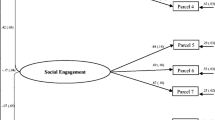Abstract
The concurrent validity of the Children's Action Tendency Scale (CATS), a self-report measure of aggressiveness, assertiveness, and submissiveness, was assessed using behavioral observations in naturalistic settings. Forty-five third- to fifth-grade children were observed over an 8-month period in a wide variety of school (and school-related) activities. Scores on the CATS sub-scales were found to correlate significantly with a variety of behavioral indices of aggressiveness, assertiveness, and submissiveness; these correlations tended to be higher for boys than for girls. Explanations for these sex differences and recommendations for the questionnaire's use are offered.
Similar content being viewed by others
References
Alberti, R. E., & Emmons, M. L. (1971).Your perfect right: A guide to assertive behavior. San Luis Obispo, CA: Impact.
Bornstein, M. R., Bellack, A. S., & Hersen, M. (1977). Social-skills training for unassertive children: A multiple-baseline analysis.Journal of Applied Behavior Analysis, 10 183–195.
Bornstein, M. Bellack, A. S., & Hersen, M. (1980). Social skills training for highly aggressive children in an inpatient psychiatric setting.Behavior Modification, 4 173–186.
Deluty, R. H. (1979). Children's Action Tendency Scale: A self-report measure of aggressiveness, assertiveness, and submissiveness in children.Journal of Consulting and Clinical Psychology, 47 1061–1071.
Deluty, R. H. (1981a). Assertiveness in children: Some research considerations.Journal of Clinical Child Psychology, 10 149–155.
Deluty, R. H. (1981b). Adaptiveness of aggressive, assertive, and submissive behavior for children.Journal of Clinical Child Psychology, 10 155–158.
Eisler, R. M., Miller, P. M., & Hersen, M. (1973). Components of assertive behavior.Journal of Clinical Psychology, 29 295–299.
Gambrill, E. D., & Richey, C. A. (1975). An assertion inventory for use in assessment and research.Behavior Therapy, 6 550–561.
Geller, M. I., Wildman, H. E., Kelly, J. A., & Laughlin, C. S. (1980). Teaching assertive and commendatory social skills to an interpersonally-deficient retarded adolescent.Journal of Clinical Child Psychology, 9 17–21.
Henderson, M., & Furnham, A. (1983). Dimensions of assertiveness: Factor analysis of five assertion inventories.Journal of Behavior Therapy and Experimental Psychiatry, 14 223–231.
Hull, C. H., & Nie, N. H. (Eds.) (1981).SPSS Update 7–9: New procedures and facilities for Releases 7–9. New York: McGraw-Hill.
Jewett, J., & Clarke, H. B. (1979). Teaching preschoolers to use appropriate dinnertime conversation: An analysis of generalization from school to home.Behavior Therapy, 10 589–605.
Keller, M., & Carlson, P. (1974). The use of symbolic modeling to promote social skills in preschool children with low levels of social responsiveness.Child Development, 45 912–919.
Kim, J.-O. (1975). Factor analysis. In N. H. Nie, C. H. Hull, J. G. Jenkins, K. Steinbrenner, & D. H. Bent (Eds.),Statistical Package for the Social Sciences (2nd ed.) (pp. 468–514). New York: McGraw-Hill.
Lazarus, A. A. (1973). On assertive behavior: A brief note.Behavior Therapy, 4 697–699.
O'Connor, R. D. (1969). Modification of social withdrawal through symbolic modeling.Journal of Applied Behavior Analysis, 2 15–22.
Patterson, G. R. (1977). Naturalistic observation in clinical assessment.Journal of Abnormal Child Psychology, 5 309–322.
Phillips, D. R., & Groves, G. A. (1979). Assertive training with children.Psychotherapy: Theory, Research, and Practice, 16 171–177.
Reardon, R. C., hersen, M., Bellack, A. S., & Foley, J. M. (1979). Measuring social skill in grade school boys.Journal of Behavioral Assessment, 1 87–105.
Reid, J. B. (1970). Reliability assessment of observation data: A possible methodological problem.Child Development, 41 1143–1150.
Ross, A. O., Lacey, H. M., & Parton, D. A. (1965). The development of a behavioral checklist for boys.Child Development, 36 1013–1027.
Taplin, P. S., & Reid, J. B. (1973). Effects of instructional set and experimenter influence on observer reliability.Child Development, 44 547–554.
Wasik, B. H., Senn, K., Welch, R. H., & Cooper, B. R. (1969). Behavior modification with culturally deprived children: Two case studies.Journal of Applied Behavior Analysis, 2 181–194.
Wood, R., & Michelson, L. (1978). Assessment of assertive behavior in elementary school children. Paper presented at the Annual Meeting of the Association for the Advancement of Behavior Therapy, Chicago.
Author information
Authors and Affiliations
Additional information
This investigation was supported by Grant 1 R03 MH37520-01 from the National Institute of Mental Health. The author wishes to extend his appreciation to Sister Jean O'Connor and to the teachers, parents, and children of the St. Philip and St. James School for their support, patience, and participation. Many thanks are offered to my “observers,” Corinne Norton, Patti Chiriboga, Pat Bertel, Amanda Fluharty, Terri Meyer, Laura Milner, Achina Palanki, Renee Pinter, Susan Brager, and (in particular) Janice Fitzkee Brown, Pat Lackey, Pam Leclerc, and Linda Hom. Gratitude is also extended to Valerie Pereira for her contributions in the early stages of the study and to Barbara Medine Deluty for her assistance in the data analysis.
Rights and permissions
About this article
Cite this article
Deluty, R.H. Behavioral validation of the Children's Action Tendency Scale. Journal of Behavioral Assessment 6, 115–130 (1984). https://doi.org/10.1007/BF01350167
Accepted:
Issue Date:
DOI: https://doi.org/10.1007/BF01350167



